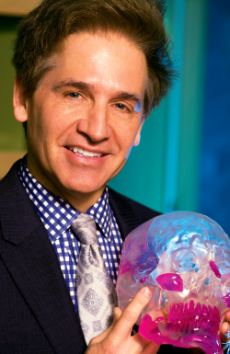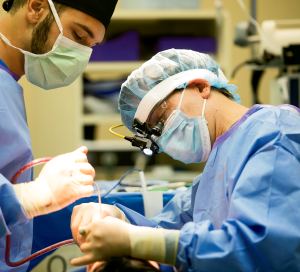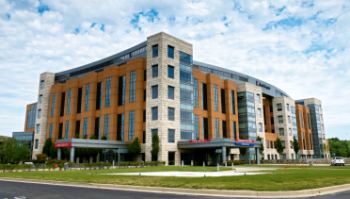
Patients travel to Indianapolis to see Dr Eppley for skull reshaping. PHOTOGRAPHY BY MARC LEBRYK.
Today’s plastic surgeons are often tasked with making more decisions about business than incision patterns, implant placements, and other aspects of a surgical plan. Not surprisingly, many are not very good at thinking like entrepreneurs, nor do they want to be.
Indianapolis plastic surgeon Barry Eppley, MD, DMD, is one of the exceptions. He is as much of a businessman these days as he is a plastic surgeon.
When the medspa craze took hold in the early 2000s, many plastic surgeons wanted a piece of this pie. It seemed that every doctor had to have one, and it had to be bigger, better, and brighter than the one down the block. Suffice it to say, some lost their shirts.
Not Eppley. He found a way to turn the traditional model inside-out so that it worked for him and his patients.
“A business has to make more money than it spends, and this is magnified when you incorporate a spa component into your practice,” he says. “The safest way is to make the spa a sideline business or a small one- or two-person operation within the practice,” he says. Other surgeons may choose to make alliances with local spas, where they swap referrals and service. Again, “This is safe and a good choice for many doctors, but it’s not your own spa business.”
RISKY BUSINESS
Eppley didn’t play it safe. When he left his academic position at Indiana University, he looked for a different way to open his practice. He choose the medspa model and opted to open his spas in hospitals—which was, and still is, considered a nontraditional location. “The spa is the main business, and as a plastic surgeon, I function inside it,” he explains.

Eppley practices within a spa.
Eppley uses biomaterials to craft custom facial implants.
And so far, so good.
Ology Spas, Eppley’s hospital-based spa concept, has two locations in Indianapolis with a total staff of 22 employees. Both spas are located within the Indiana University Health community hospital network. These are full-service facilities offering aesthetic surgery procedures, medical skin care, ayurvedic therapies, and massage, as well as retail items such as clothing, shoes, makeup, perfumes, and a host of seasonal items that often catch passers-by’s eyes and draw them into the spa.
“We didn’t want the medspa on a street corner, so we put them inside hospitals on the ground floor in key locations,” he says. This provides instant credibility as well as visibility.
When he says “we,” he is referring to his Ology co-founder-turned-wife, Andrea Bradley-Stutz. The two clicked so much while brainstorming about the spa concept that they married 4 years ago—about 4 years after they opened their first hospital-based spa in Carmel, Indiana.
“She is the real genius behind the Ology Spa concept as she has designed and built everything from the floor plans to the treatment menus to its marketing. She runs a tight ship with all the staff as the director,” Eppley says. “A successful medspa is better off having a director that knows all aspects of the business rather than just a practitioner turned manager.”
LOCATION, LOCATION, LOCATION
There were definitely some learning curves during the spa’s early years. “We did not have great success until we took our retail space and offerings and doubled them,” Eppley says. “It was a leap of faith, and we spent a fair amount of money to do it.”
“In addition,” he says, “some of the services we thought would be popular were not, and others were simply not profitable.”
Convenience and visibility are really important for any start-up retail business, Bradley-Stutz adds. “If we had been on an upper floor, I don’t think we would have been successful,” she says. “A lot of the medspas that went out of business were in office building settings and not on the first floor.”
Just 2% to 3% of business comes from within the hospital. The rest come to the spas by happenstance by walking by as they are coming in for medical services or visiting someone in the hospital.
So how do they hear about the spa? “For my practice, the Internet has been a critical marketing tool. But the spa business is local, so it doesn’t need such a strong Internet presence,” Eppley says. “In plastic surgery, every sale is for thousands of dollars, and in a spa business most sales are $75 to $150,” he says. “The focus needs to be more on local efforts such as newspaper and magazine ads, alliances with local businesses, and Facebook.”

Ology Spas are based in hospitals.
Ology boasts a full menu of spa services.
This surgeon-turned-retailer has also learned a lot about the shopper’s psyche. “Women like to shop, and you have to have things that make them shop,” he says. “Retail items don’t require any effort to sell. It’s not a labor-intensive sale like a facial or a massage.”
Impulse sales can be key drivers of business if you position the goods correctly.
One of the real lures of the Ology Spas is clothing. “It has to be seasonal, and it has to be at a very good price point,” Eppley says. “People will wear it for one season and be done with it,” he says. “They are not coming in to buy a $300 dress, but they will buy a $35 hat in the summer or $18 fingerless faux fur gloves in the winter.”
This hospital-based spa model did not really catch on across the map. According to Eppley, there is no greater number of such medspas today than 10 years ago. The International Spa Association does not track statistics on hospital-based spas.
“Hospitals learned the hard way that you don’t just create a spa space and business comes,” he says. “It is not the same as opening a pediatrician office or an oncology office. It is a retail business, and that is a difficult fit with an insurance-reimbursed industry.”
It’s also pricey. “The square footage cost is 20 to 30 percent more than what you would find in a strip mall or office location,” he says.
Eppley and Bradley-Stutz have been asked to open additional Ology Spas in other hospitals, but so far they have declined. “Having a third or fourth child could jeopardize the other two,” he says. “A good business model still takes experienced on-site management to work.”
Inside the spas, Eppley has a bustling surgical practice. “Providing a complete menu of aesthetic face and body surgeries attracts patients independently as well as gets guests crossing over from the spa,” he says. “It is a two-way street.”
NICHE SPECIALTIES
His unique training and background as a board-certified plastic and oral and maxillofacial surgeon have given rise to several niche areas of his aesthetic practice, including structural facial surgery and skull reshaping. Many patients seeking these services travel to Indianapolis to see Eppley after reading about his expertise on the Internet.
Some patients have prominent brow bones, a recessed forehead, a flat spot on the back of their head, or other skull issues that they don’t like. “These are not patients with craniofacial deformities, but people who have aesthetic concerns about the shapes of their heads,” Eppley says.
Eppley also performs structural facial surgery for both men and women who want a stronger gender identity, whether a more masculine, well-defined face or a softer, more delicate female appearance. “You have to have confidence with manipulating cranial and facial bones, and know where and how to place incisions,” he says of the delicate and intricate procedures.
He has been able to apply his dental training with biomaterials to his aesthetic practice. While many facial implant patients do well with off-the-shelf preformed materials, they are not right for everyone. For some patients, Eppley will hand-carve his own custom-fitted facial implants, which are then manufactured for surgery. This has become an in-demand service because of his Internet marketing.
These niche procedures are responsible for his popularity among many male patients. “A lot of younger male plastic surgery of the face is based on changing structure, not reversing aging,” he says. “Jawline and other facial enhancements have become very popular, and the vast majority need facial implants to achieve it.”
While there are aesthetic desires and surgical technique differences between plastic surgery in men and women, Eppley has also noticed many psychological nuances as well.
“It’s more difficult to manage male expectations, and the consultations take twice as long,” he says. This is because they have a higher threshold for wanting the procedures than women, and as such, they will have more questions and concerns. They often want great detail about the surgery and are very prone to try and manipulate the changes you discuss down to the millimeter level.
“A significant percentage of young men are impatient with the recovery process and are quick to want a revision,” he says. “When I talk to men during the consultation, I tell them that this will happen and that we are not going to consider the concept of revisional surgery for a minimum of 3 months … no matter how much they beg.”
And they do beg, he says. Fortunately, Eppley is not easily swayed, which is perhaps one of the reasons that his hospital-based medspa concept is standing the test of time.
Denise Mann is the editor of PSP. She can be reached at [email protected].








